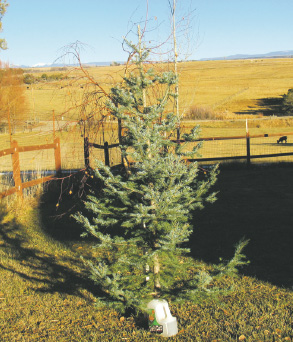Here it is December and your mind is slipping off into dreaming of sugar plums and suddenly you smell the pungent odor of a Christmas tree wafting through your mind. Well, maybe that is not quite the smell you were remembering. What you are now smelling is the dust from the plastic tree that had been stored in a box in the garage, and oh, no, there are mouse droppings in the box; I might get hantavirus, so throw the whole thing out!

Dexter Gill’s naturally grown sub-alpine fir tree — irregular, unbalanced and individual, like everyone. No two are alike.
Now, where to get a new tree? Well, I see the grocery store has some real trees from a tree farm somewhere, but I would feel like the “Grinch that stole Christmas” going to snatch up a tree while wearing a mask. Wait – someone said you can cut your own tree that will be fresh and you can make it a family outing and experience. Yes you can, just pick up a permit from the Forest Service, with instructions on what kind of tree needs to be thinned out to be used as a family Christmas tree.
Well, that is great, but where do Christmas trees grow? I know where there are some pines, spruce and aspens, but I haven’t seen any Christmas trees in the forest! The confusion arises from the marketing media giving you the picture of a perfect dense conical-shaped tree form that bears little to no resemblance to a natural-grown tree in the forest. When you are used to the “factory produced” tree, the natural ones in the forest all look like Charlie Brown’s scraggly little tree to the average person. It is kind of like seeing pictures of some gorgeous models before getting their 6-hour makeover to be presentable. You have to see the tree for its potential for your purpose.
If there is not a special “species” of Christmas tree, then what do I look for? It is simply personal preference. Here in our corner of Colorado there are about six different species that people choose from: juniper, piñon pine, blue and Engelmann spruce, sub-alpine and white firs. This year I was able to track down a nice sub-alpine fir on a snowy north slope up on Haycamp Mesa. Once I wrestled it down and got my official Forest Service red tag on, it came along very willingly, sensing that it would get to be inside all decorated out in lights and tinsel, and sitting in plenty of water to drink, no longer having to be concerned with a coyote coming by to insult it.
There are two specific trees the forest manager does not want you to cut, the ponderosa pine and Douglas fir. The ponderosa is not a particularly good Christmas tree anyway. Remember Charlie Brown’s scraggly tree? Well that looked like a young ponderosa. The Douglas fir is better at producing timbers for your house than Christmas decoration. Personally I don’t like it as the limbs are too limber and really sag with lights and bulbs. The Douglas fir is not really a “fir” anyway, it is its own species but similar to a hemlock, which is why the scientific name is Pseudotsuga, with “Pseudo” defining it as false hemlock.
I like any of the two spruces or the two firs. You find a good possibility, which is it, a spruce or a fir? Not that it matters, but a good test is to grab a branch back from the tip a ways, with your bare hand and give it the “ouch” test. If it sticks your hand with sharp prickles it is a spruce. If it is more smooth and soft it is a fir. To most people, the difference between spruces and firs is minor and doesn’t matter as long as you like it.
I hope you don’t let the false narrative of “woodsman, spare that tree” interfere with you being able help improve the health of the forest and watershed. The forest is all in serious need of thinning, to improve growth and health of trees and forage as well as producing water for man and beast. The spruce and true firs tend to grow too thick, shading out grasses and other ground cover needed for ungulates and other wildlife, so Christmas tree harvesting is helping to thin the forest, thereby benefitting man, beast, wildlife, watershed, while reducing wildfire fuel loading. This is a win, win, win for everyone! So if you want to help out in true conservation (“wise use of ”), harvest a local Christmas tree with the family, and even bring back a “Yule Log” or two with it. Need to do this while we still can, the anti-management and use groups are locking up most of the forest lands into pseudo wilderness areas, preventing conservation, use and management.
Once you get the tree in the house, be sure to use a good support system that provides a water basin to keep the tree moist, and certainly keep it away from heat sources, especially stoves and other heaters to be fire safe! Above all, remember the reason for the Christmas season is thanking our Creator for providing Christ to give us a true hope for the future. The “tree” is to remind us of His great gift, as we share it with others. May God bless you all and thank you for your support this past year. Hope to see you next year, God willing and the creek don’t rise! Actually hope the creek does rise this year, we need it!
Dexter Gill is a retired forest manager who worked for private industry, three Western state forestry agencies, and the Navajo Nation forestry department. He writes from Lewis, Colo.

